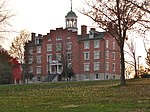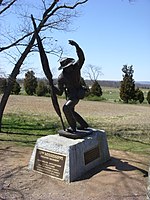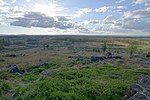Gettysburg Armory

The Gettysburg Armory is a former National Guard armory located at Gettysburg, Adams County, Pennsylvania. It was listed on the National Register of Historic Places in 1990. The 61x96 ft (44 ft high) Art Deco facility was constructed as a $43,331 Works Projects Administration project for the local National Guard unit (commanded by Lt Ralph C. Deitrick in 1933).[1] The two-story building housed a garage and repair shop for military vehicles, a classroom, administrative space, and a drill hall. From the beginning, the Armory was used not only by the National Guard, but also by the local community, for sporting events and community meetings. In 1944, the Gettysburg Armory was used as a temporary German Prisoner of War camp while the official camp was being constructed on the Gettysburg Battlefield. Later the building was designated as a public fallout shelter by the National Fallout Shelter Survey. In 2010, the building was vacated by Battery B, 1/108th Field Artillery after a new readiness center was constructed in South Mountain. In 2013, the Armory was transferred to the private sector by the Pennsylvania General Assembly.
Excerpt from the Wikipedia article Gettysburg Armory (License: CC BY-SA 3.0, Authors, Images).Gettysburg Armory
Armory Road,
Geographical coordinates (GPS) Address Nearby Places Show on map
Geographical coordinates (GPS)
| Latitude | Longitude |
|---|---|
| N 39.826944444444 ° | E -77.243888888889 ° |
Address
PA National Guard
Armory Road
17325
Pennsylvania, United States
Open on Google Maps









